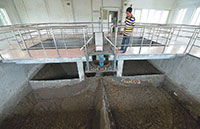Disposal of construction debris growing problem in urban areas
By Xu Wei/Zhou Mo/Zhou Wenting (China Daily) Updated: 2015-12-25 07:35Development of recycling industry must be encouraged, experts say
Most recyclers of construction waste are struggling to make ends meet, despite waste management becoming a growing challenge for cities nationwide, according to business owners and experts.
Only 5 percent of China's construction waste is recycled, compared with about 90 percent in the European Union and 97 percent in Japan and South Korea, said Chen Jialong, deputy director of the National Committee of Construction Waste Management and Recycling at the China Association of Urban Environmental Sanitation.
On Wednesday, the Beijing Daily reported that the Chinese capital generates about 30 million metric tons of construction waste every year, but less than 30 percent of it is recycled. A recycling facility in the city, owned by the Shougang Group, is largely unused, with just 20 percent of its production capacity in operation, the report said.
Zhang Fuqiang, a manager with Shougang, said construction outfits rarely transfer their waste to the company, which is struggling to obtain large amounts of raw material.
According to Chen, waste recyclers are unable to obtain large amounts of construction waste that can be transformed into usable materials, such as bricks, via grinding and compression. "That means the costs of the products are much higher, so they become much less competitive in the market," he said.
He Gengxin, a researcher at the Chinese Academy of Building Research, who has researched construction-waste disposal methods, said many recyclers have to undercut their competitors to win contracts to transport and recycle the waste, which results in wafer-thin profit margins.
"In most areas, demolition work, the transportation of waste and recycling operations are controlled by several different units, and coordination between them is poor," he said.
Last year, the annual October report into the utilization of resources, commissioned by the National Development and Reform Commission, found that only 5 percent, or 50 million metric tons, of the total 1 billion metric tons of construction waste generated in 2013 was recycled.
Meanwhile, only 20 percent of cities in China have formulated regulations on the recycling of construction waste.
"One important reason is that most cities still regard waste as a source of pollution, and an overwhelming emphasis is placed on the prevention of pollution in the transportation process," Chen said.
He believes the country should encourage the development of the waste-recycling industry by enacting legislation to prevent random dumping and by imposing high fines on companies that dump waste rather than transfer it to recycling facilities.
"The solution is to turn the waste into a resource. If we continue to regard it simply as waste ready for disposal, rather than recycling, it will become harmful sooner or later," Chen said.
- Before and after photos of Shenzhen landslide
- One survivor rescued from Shenzhen's landslide
- First survivor pulled out 67 hours after Shenzhen landslide
- Rescuers search survivors after devastating landslide hits Shenzhen
- Shenzhen entrepreneur sets sights on 3D sensing
- Around 900 people evacuated as landslide hits Shenzhen
- Civil aviation to add 200 more international routes in 2016
- More than money: Employees in China demand cleaner office air
- Shanghai's population growth expected to plateau
- Disposal of construction debris growing problem in urban areas
- Xi stresses correct implementation of 'One country, Two systems' in HK
- Bottled air breeds hot air in smoggy China
- Bid to change family planning law stirs debate
- Blacklist to record bad behavior by tourists
- HK, Macao play key roles, Li says
- China takes on mediation role







